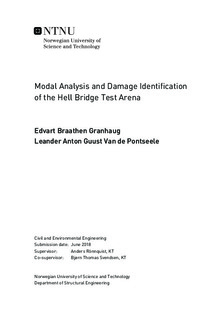Modal Analysis and Damage Identification of the Hell Bridge Test Arena
Master thesis
Permanent lenke
http://hdl.handle.net/11250/2564526Utgivelsesdato
2018Metadata
Vis full innførselSamlinger
Sammendrag
The purpose of the Hell Bridge test arena is to assess new sensor technology, monitoring algorithms and SHM techniques on a real structure in a controlled environment to establish reliable, cost-effective and time efficient inspection methodologies. As the Hell Bridge test arena is a project expected to last for many years, the purpose of this paper is narrowed down to assessing the global dynamic behavior of the Hell Bridge Test Arena using numerical modelling and full-scale measurements, and further to investigate a known damage in the joint connection between a stringer and cross girder by dynamic analysis in the search for new simple techniques for damage identification. The known damage was investigated by local measurements of imposed vibrations and further implemented in the numerical models.
The numerical modelling was performed in Abaqus. Two FE models were constructed, one simple beam model and one more detailed shell model. The global dynamic behavior was assessed by performing an eigenvalue analysis of the two models, which were compared to the results from the system identification methods. The system identification methods used were Peak Picking and Frequency Domain Decomposition. The numerical models were further used to introduce the known damage in the connection between stringer and cross girder in two different ways. Finally, numerical simulations of imposed vibrations were performed and compared to the full-scale measurements through the established damage identification techniques.
The results show that a beam model is sufficiently accurate for the purpose of this paper and that the damage is well represented by allowing the stringer of the damaged structural component to move free vertically and rotate free about the local transversal beam axis. Further the results show that damage identification is possible by the use of the simple techniques Moving Standard Deviation, Cross Correlation and Normalization, all techniques in the time domain.
